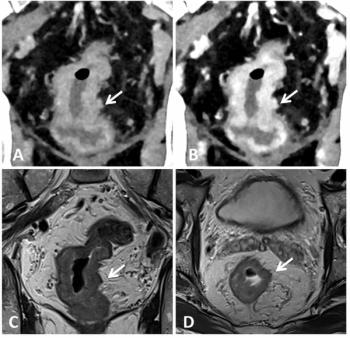
Prudent gadolinium contrast use halts NSF
Simple strategies, based on past experience with contrast-enhanced MRI for patients with compromised renal function, have helped radiologists and allied physicians bring the incidence of nephrogenic systemic fibrosis, a rare but deadly skin disorder, under control.
Simple strategies, based on past experience with contrast-enhanced MRI for patients with compromised renal function, have helped radiologists and allied physicians bring the incidence of nephrogenic systemic fibrosis, a rare but deadly skin disorder, under control.
NSF is strongly associated with gadolinium-based MRI agents administered to kidney disease patients. Symptoms, including a swelling and tightening of the skin, usually develop over several months, though rapid-onset disease affects of 5% of patients. The first case was documented in early 1997. The International Center for Nephrogenic Fibrosing Dermopathy Research at Yale University had identified 215 confirmed cases as of January 2008.
Studies presented at the 2008 RSNA meeting shed light on how to defeat NSF, according to Dr. Martin Prince, professor of radiology at Weill Medical College of Cornell University.
"Though we don't fully understanding NSF, we have learned enough to virtually eliminate it as a concern," he said in an interview.
Prince presented results at the 2008 RSNA meeting from case reviews involving 83,121 patients at Columbia Presbyterian Medical Center and Cornell New York Hospital from January 1997 to July 2007.
Of 31 biopsy-confirmed NSF cases at the two hospitals, Prince identified 15 where the patient received gadolinium contrast at one of the two facilities.
On the basis of that evaluation, Prince found that a single dose of gadolinium-based contrast media is safe. No NSF cases were associated with 74,124 patients who received a single dose. For dialysis patients who have estimated glomerular filtration rates (eGFR) of less than 15 mL/min, no new cases appeared after the hospitals began administering 0.1 mmol/kg doses of gadolinium-based contrast when a contrast agent was recommended for MRI and same-day dialysis was performed on these patients.
The study found that the NSF incidence rate dropped from 8.8% to 0.4% for patients with eGFR less than 15 mL/min when dialysis was performed within two days of contrast administration.
"If the only thing you did was restrict yourself to low dose [of contrast], you would greatly reduce NSF incidence," Prince said. "We've found that the hospital with the highest incidence of NSF was the one that got into the habit of using high doses."
Historically, 86% of the contrast-enhanced MR procedures at the two hospitals involved gadodiamide (Omniscan). Gadopentetate (Magnevist) and gadoteridol (ProHance) accounted for 10% and 1% of the enhanced scans respectively, Prince said. Because of medical records problems, however, researchers did not examine possible correlations between contrast media type and NSF, he said.
The highest incidence of NSF was associated with the 58 patients with acute renal failure who received a high dose of gadolinium-based contrast medium while their serum creatinine levels were rising and for whom dialysis was delayed for at least two days after contrast injection. Prince said. Eleven of these patients (19%) developed the disease.
High contrast dose was a major contributor to NSF. Ten cases were associated with the administration of a single dose of at least 32 mmol/kg to 5119 patients at the two hospitals. The incidence rate was 0.2%. No cases were reported for the 5725 patients who received more than one standard dose.
NSF also never appeared among patients with an eGFR greater than 30 mL/min, but the incidence rate was 0.5% for patients with eGFR between 15 and 30 mL/min, Prince said.
In a separate study, University of Vienna researchers established a positive association between cumulative dose of gadolinium-based MR contrast media and NSF from a retrospective review of records from 552 patients with end-stage renal disease from 1997 to 2007.
Dr. Gertraud Heinz-Peer and colleagues at the Medical University of Vienna Medical Center in Vienna examined the prevalence of NSF among 195 dialysis patients exposed to gadolinium-based contrast in 325 MR procedures.
Six patients (1.6%) developed NSF. Five cases followed gadolinium-enhanced MR. They developed symptoms an average of 5.4 months after their last gadolinium infusion. Diagnosis was confirmed with a deep skin biopsy or medical or histopathological records. Four of six patients were on hemodialysis. One patient showed NSF symptoms 18 months before CE-MRI. One patient died.
The researchers established no correlation between NSF onset and patient age, gender, underlying kidney disease, type of therapy, serum phosphate, calcium or iron concentrations, number of gadolinium contrast administrations, and the mean residual renal clearance.
However, mean dose was a factor. Patients who developed NSF were administered an average 63 mL of contrast compared with 30 mL for patients who did not develop the disease. Other significant cofactors were a history of thrombosis, recent surgery, and a combination of hemodialysis and peritoneal dialysis, Heinz-Peer said.
For more information for the Diagnostic Imaging and SearchMedica archives:
Newsletter
Stay at the forefront of radiology with the Diagnostic Imaging newsletter, delivering the latest news, clinical insights, and imaging advancements for today’s radiologists.



























